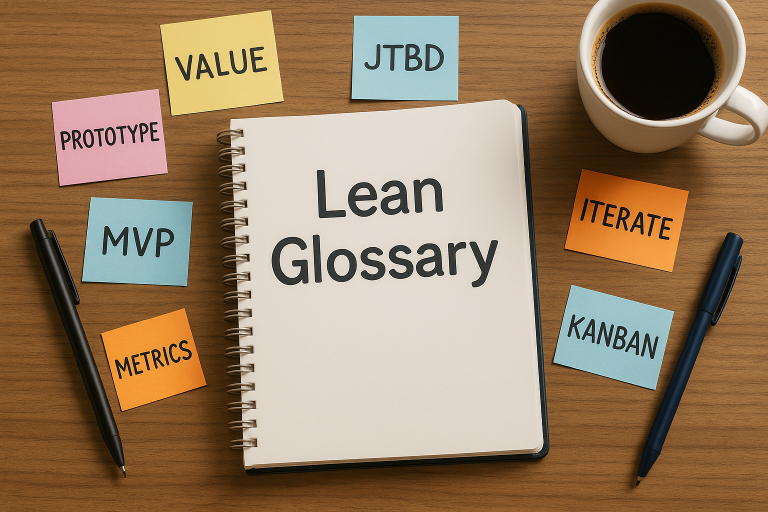Jargon can be a barrier when you’re moving fast. This glossary clusters core lean‑product vocabulary into five themed groups so you can ramp up your team—and investors—without pausing to Google mid‑meeting. Each group opens with a quick explainer, followed by bite‑sized definitions (two to three sentences each) you can drop into Slack threads or pitch decks.
Lean Principles
These are the philosophical roots—mindsets that shape every decision from backlog grooming to funding strategy.
build‑measure‑learn
Coined by Eric Ries, this loop captures the essence of lean: build something small, measure how real users react, learn from the data, and iterate. Success is measured in validated learning, not lines of code.
validated learning
Evidence‑based insights that either prove or disprove a business assumption. When you can move a metric—or fail to—you know your next priority.
waste
Any feature, meeting, or report that doesn’t accelerate learning or deliver customer value. Spotting and eliminating waste keeps burn rate low and focus sharp.
Experimentation Metrics
Numbers that reveal whether an idea is gaining traction or needs a rethink.
activation rate
The percentage of sign‑ups who reach their first “aha” moment—often a leading indicator of retention. Boosting activation usually gives the biggest bang for buck early on.
cohort analysis
Grouping users by sign‑up date or segment to observe how behavior changes over time. It helps you separate product improvements from seasonal or marketing noise.
north‑star metric
A single, high‑level measure that best captures your product’s delivered value—think daily active users or dollars of GMV. It aligns teams and prevents vanity metric chasing.
Product Artefacts
Concrete outputs used to test hypotheses at different stages.
mvp (minimum viable product)
A functional slice that delivers just enough value to learn whether users will adopt or pay. StoriesOnBoard’s story maps are great for shaving an MVP down to its critical path.
prototype
A clickable or high‑fidelity mock‑up used to validate usability before coding begins. It answers “do people understand how to use this?”
proof‑of‑concept
A technical demo that proves a risky piece of engineering can work—often throwaway code. It safeguards against investing in impossible builds.
Agile Process Essentials
Ceremonies and artefacts that keep lean teams shipping fast without chaos.
sprint
A fixed‑length (commonly one‑ or two‑week) timebox during which a team commits to deliver a small, releasable increment. It enforces focus and provides regular learning checkpoints.
retrospective
A short meeting at each sprint’s end where the team inspects what went well or poorly and decides how to improve. Continuous improvement in action.
kanban wip limit
A cap on how many tasks can be in progress at once. It reduces context switching, exposes bottlenecks, and accelerates flow.
Customer Insight Methods
Tools for understanding the humans behind the metrics.
job‑to‑be‑done (jtbd)
A framework that describes what a user hires a product to accomplish. Focusing on jobs rather than demographics helps uncover non‑obvious competitors and opportunities.
empathy interview
A qualitative conversation that digs into emotions and motivations, not just surface problems. Done early, it shapes value propositions before a single pixel is designed.
net promoter score (nps)
A simple survey asking users how likely they are to recommend your product on a 0‑10 scale. While imperfect, trends in NPS often flag churn risks or product‑market fit progress.
Key Takeaways
- Lean vocabulary encodes decades of startup pattern‑matching—mastering it shortens decision time.
- Map a term back to its purpose: mindset, metric, artefact, process, or insight.
- Anchor discussions in shared definitions to kill bike‑shedding and keep experiments moving.
